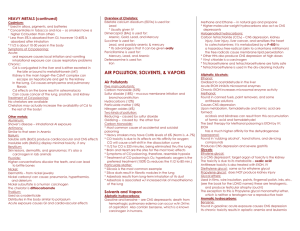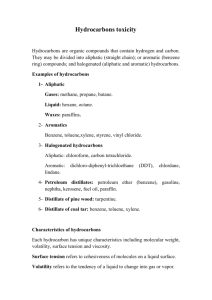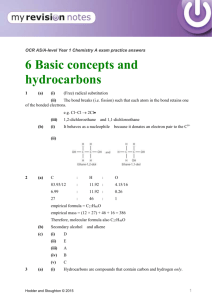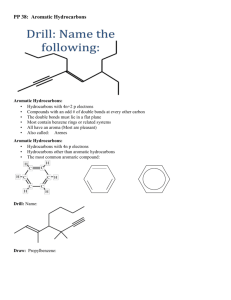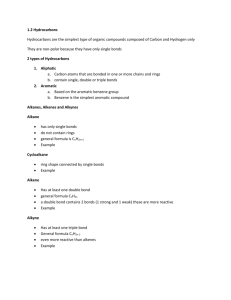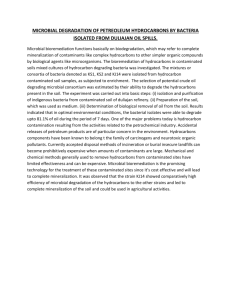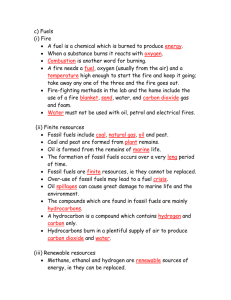Hydrocarbons: Hydrocarbons are classified according to if they are
advertisement
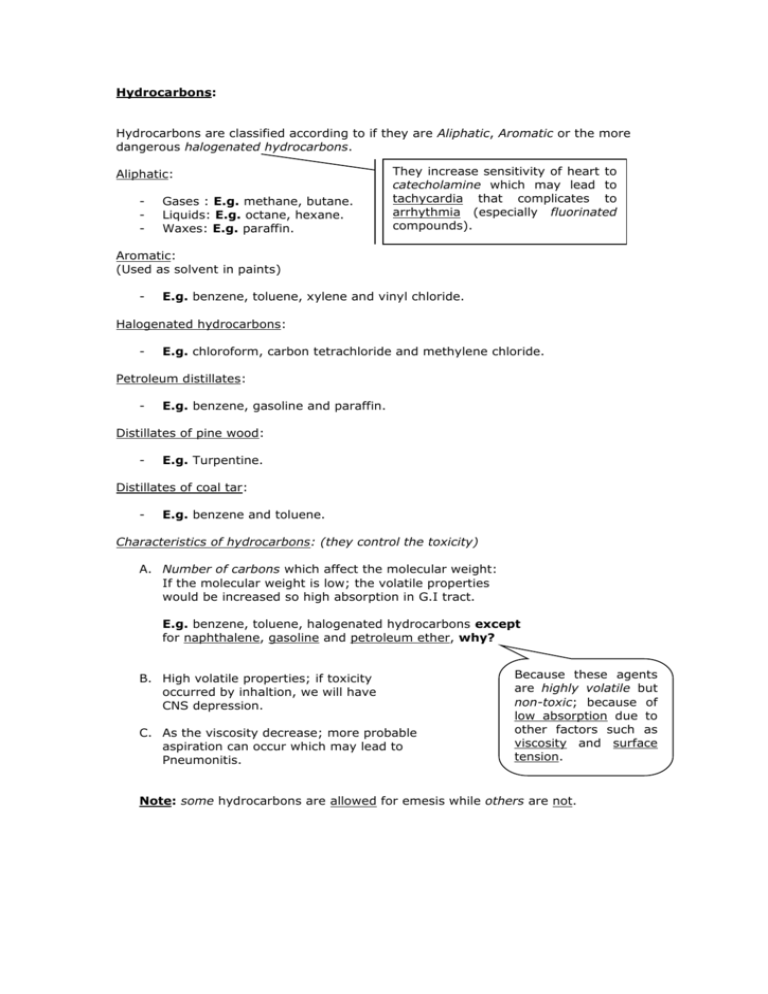
Hydrocarbons: Hydrocarbons are classified according to if they are Aliphatic, Aromatic or the more dangerous halogenated hydrocarbons. Aliphatic: - Gases : E.g. methane, butane. Liquids: E.g. octane, hexane. Waxes: E.g. paraffin. They increase sensitivity of heart to catecholamine which may lead to tachycardia that complicates to arrhythmia (especially fluorinated compounds). Aromatic: (Used as solvent in paints) - E.g. benzene, toluene, xylene and vinyl chloride. Halogenated hydrocarbons: - E.g. chloroform, carbon tetrachloride and methylene chloride. Petroleum distillates: - E.g. benzene, gasoline and paraffin. Distillates of pine wood: - E.g. Turpentine. Distillates of coal tar: - E.g. benzene and toluene. Characteristics of hydrocarbons: (they control the toxicity) A. Number of carbons which affect the molecular weight: If the molecular weight is low; the volatile properties would be increased so high absorption in G.I tract. E.g. benzene, toluene, halogenated hydrocarbons except for naphthalene, gasoline and petroleum ether, why? B. High volatile properties; if toxicity occurred by inhaltion, we will have CNS depression. C. As the viscosity decrease; more probable aspiration can occur which may lead to Pneumonitis. Because these agents are highly volatile but non-toxic; because of low absorption due to other factors such as viscosity and surface tension. Note: some hydrocarbons are allowed for emesis while others are not. Mechanism of toxicity: Inhalation: direct effect on the lung and CNS depression. Ingestion. 1- Pulmonary effects: especially high aspiration (Pneumonitis), cough and shortness of breath. 2- CNS effects (Indirect): less than 30 % affected usually by hypoxia and acidosis. (Effects on CNS are indirect unless very high doses are ingested). 3- G.I. effects (Direct): local irritation and burning lead to nausea and vomiting. (Emesis will increase the aspiration). 4- Hepatic problems (in high amounts). 5- Cardio vascular symptoms. Characteristics of hydrocarbons poisoning: (Petroleum distillates and Turpentine) i. ii. iii. iv. v. vi. vii. Odor in breath. Peripheral numbness. Parasthesia. Weight loss. Excitement. Restlessness. BMP anemia. Management and treatment: a. If the ingested amount is very high; induce emesis because it will lead to CNS toxicity more than respiratory problems. b. If only small amounts are ingested; don't induce emesis; because it may lead to aspiration (respiratory effects will be enhanced). Emesis is not used in the following cases: High viscosity (except low viscosity e.g. mineral seal oil). High surface tension. Grease and lubricating oils. Gastric evacuation is used for: 1) Large quantities of petroleum distillates. 2) Metal ions-containing hydrocarbons. Cyanide: It's a chemical compound found in industrial chemicals, seeds of apricot, almond, peach and cherry. All the mentioned above contains a substance called Amygdaline which can be hydrolyzed into Cyanide (HCN). Toxicity kinetics: Very toxic compound (absorbed orally). LD50%= 2 mg/kg. Clinical signs: Hypoxia, headache, Dyspneia, nausea, vomiting, ataxia, seizures and coma in late stages. Laboratory signs: - Cyanosis. Electrolytes check. Treatment: 1. 2. 3. 4. 5. 6. Nathiosulfate. Methylene blue. Amyl nitrite and sodium nitrite both together. Oxygen. NaHCo3 for severe acidosis. If no response give hyperbaric oxygen (oxygen at high pressure e.g. 4 atmospheres, but it must be controlled and monitored). Nathiosulfate: (if no response; repeat the dose) CN + thiosulfate Sulfate Transferase Thiocyanate + Sulfite Salt excreted by the kidney. Amyl nitrite and sodium nitrite: (10 ml I.V. bolus) These agents induce Methemoglobinemia (destroy ferric). The enzyme responsible for the transport of electrons in the body is called cytochrome oxidase enzyme (control the respiration of cells). Ferric inhibit this enzyme; which lead to inhibition of electron transport system. The function of sodium nitrite is to compete with cyanide on iron leaving hemoglobin or cytochrome oxidase free. Mechanism of cyanide toxicity: A. Hypoxia: cellular hypoxia by binding of cyanide and ferric instead of oxygen. B. Cyanide and ferric bind to cytochrome oxidase enzyme (interfere with oxidative phosphorylation) and inhibit it resulting in inhibition of electron transport system and impairment of cellular oxygen utilization. Decreased aerobic respiration will decrease Pyruvate which enters Krebs cycle and result in high lactate concentration and lead to acidosis.
